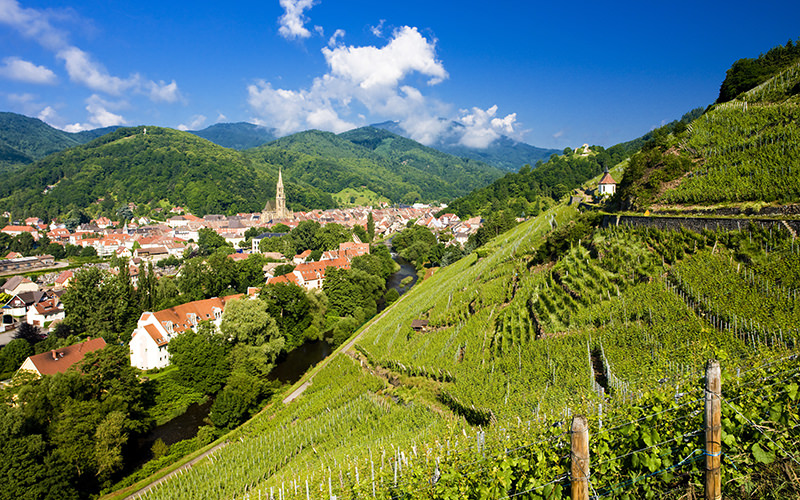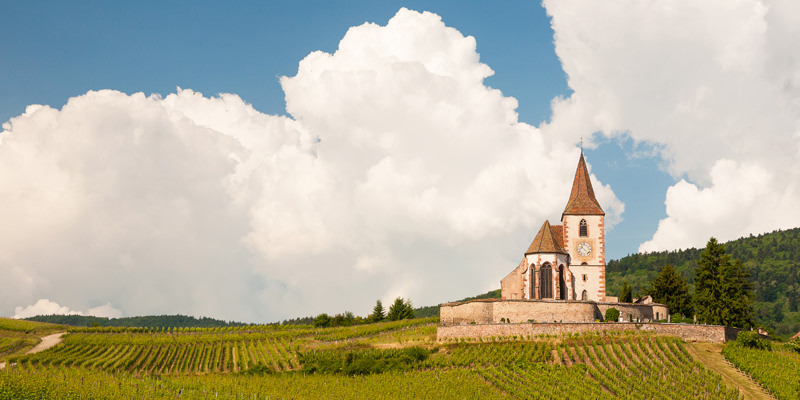What, exactly, makes a wine “food friendly”? The most basic answer is: when you take a sip, you begin to salivate, and begin imagining a dish that would go well with the juice. It’s something personal and subjective, yet most sommeliers would agree that high acidity, pronounced minerality, and complex structure are the essential ingredients of a superb food wine.
One region that’s under appreciated, but which offers a stellar range of wines to pair with all sorts of cuisine, is Alsace, in the northeast of France. At various points in recent history, Alsace was part of Germany, and it still carries many of those culinary and cultural traditions. But as a wine region, Alsatian identity is unique, irrespective of what country it belongs to, because it has a special geography. With the Vosges mountains forming a border to the west, and the Black Forest to the east, Alsace is a series of valleys and peaks running north to south, with beautiful, steep hills that comprise the 51 Grand Cru sites, the very best vineyards.
Alsace is known mostly for its white wines, primarily top-notch, mostly dry Riesling, Gewürztraminer, and Pinot Gris, but also very lovely and fresh Muscat, Sylvaner, and Pinot Blanc. There is some Alsatian Pinot Noir, as well, and it can be very good, but it is also difficult to find.
You may be thinking: This sounds like a region that makes sweet wines. While it’s true that Riesling, Gewürtz (an affectionate nickname), and Pinot Gris can all develop high sugar levels, it is definitely possible to make these wines dry, as well—and that is increasingly the style in Alsace. Even when there is some residual sugar in the wines, the cool breezes of Alsace’s hills and the mineral-rich soils lend a powerful acidity to the juice, which effectively overpowers the sweetness.
To fully appreciate Alsatian wines, it’s important to understand how paramount gastronomy, and wine pairings, are in the region. Virtually every noteworthy winemaker has a clear idea of dishes and even specific ingredients that pair with their wines. This region has deep affection for cooking, and the wine and food have long been crafted to go together. But even if Alsatian cuisine, which highlights pork, game, foie gras, and seasonal vegetables, isn’t your thing, you’ll find that these wines, with their salinity and fruitiness, are incredible matches for spicy Asian food.
Another cool thing about Alsace is the prevalence of organic and biodynamic producers. Largely due to the dry, windy climate, about 15 percent of grape growers farm without chemicals, making it the strongest organic wine region in France, and about as many domaines (that’s French for “estate”) in Alsace are biodynamic, too. You can taste these healthy vines in the juice—plus, it’s better for its makers and the environment.
Alsatian wines are also relatively affordable. You can find fantastic bottles from Alsace at half the price of Burgundy, for example. Use my guide to the grapes and producers of Alsace, below, to begin exploring these food-friendly wines. Keep in mind that all fine white wines should be served at around 55 degrees Fahrenheit—not straight out of the fridge, or you won’t experience the aromatics fully. All of these wines should be cellared if you can resist drinking them now.
Riesling
Alsace is famous for its dry and off-dry Rieslings, usually from their top, Grand Cru hills. Alsatian Riesling is often full-bodied with wonderful texture, hints of petrol on the nose, notes of peaches and apricots on the palate, and often a searing acidity. Most Grand Cru Rieslings need at least a few years of bottle aging, so look for something from 2013 and back, if possible. Riesling with pork is superb; also try it with young goat cheese.
For Riesling, a good approach is to explore the Grand Cru wines of some of Alsace’s longest-standing, family run domaines. From Domaine Trimbach, the 2009 “Fréderic Émile,” from a blend of two Grand Cru sites located right beside each other, is showing beautifully right now, with some smokiness and hints of grilled peaches. The ’08, to be released soon, is also great, with more concentration and also high acidity.
There are wonderful Riesling expressions coming from the “Schlossberg” Grand Cru, Alsace’s best-known and very steep hill, and the first to be established as a Grand Cru site in 1975. Schlossberg has granite bedrock soils that highlight Riesling’s minerality. Historic estate Domaine Weinbach’s 2015 “Schlossberg” Grand Cru, a biodynamically farmed site on granite soil, is bright, mineral, and lemony, perfect for salads or light meats. To try a quirky, barrel-fermented Riesling—in contrast with most Alsatian producers who prefer to ferment wine in stainless steel—try the low-sulfur “Schlossberg” bottlings from Christian Binner; they typically have a deep golden color and a smoky notes, and tastes of stewed apricots and ripe fruits. Biodynamic producer Bott-Geyl has a spectacular “Schlossberg” Riesling, too—grassy, bright, and smoky.

Gewürztraminer
Poor Gewürtz has a reputation of being flabby, sweet, and uninteresting. While it is a grape that becomes very ripe, an experienced winemaker and the right terroir can produce a delicious, balanced, high-acid Gewürtz. It can be complex, fruity—think apricots and yellow plums—but also dry and mineral, and goes fantastically with rich foods like foie gras, pâté, and game like venison.
In Alsace, Gewürztraminer is often grown on limestone and sandstone soils of the Grand Crus, to emphasize the grape’s potential for finesse and minerality. The “Steingrübler” Grand Cru is one such vineyard site, and from there you can try excellent Gewürtz wines from biodynamic domaines Albert Mann and Barmès-Buecher. Also look for Domaine Paul Blanck’s 2009 Vielles Vignes “Furstentum” Grand Cru, made from old vines in limestone soils. Biodynamic Domaine Léon Boesch makes a floral, full-bodied, and slightly off-dry Gewürtz from the Grand Cru “Zinnkoepfle” site, fermented in oak, and which is extremely balanced and pleasurable.
Pinot Gris
Often, Alsatian Pinot Gris (a cousin of Pinot Grigio) does retain a bit of residual sugar, resulting in an off-dry wine. Alsace-based sommelier Romain Iltis, who earned the title of Best Sommelier in France in 2012, says that Alsatian Pinot Gris is like “a white wine with a red wine structure” because it has qualities resembling tannins; its fruitiness makes it wonderful alongside salty foods, he adds. This is a great opportunity to experience how a lightly sweet wine, as long as it is made well and has enough acidity, can age beautifully and be an ideal companion to spiced dishes like Thai or Szechuan.
The Pinot Gris from biodynamic domaine Albert Boxler, from their “Brand” Grand Cru, shows how lively and fresh the grape can be, but still very complex and floral. Albert Mann has a beautiful 2010 bottling from their “Furstentum” Grand Cru, with a rich, golden color, tropical notes, a hint of sugar and plenty of acidity. In terms of dry Pinot Gris, I also highly recommend: any of the pioneering biodynamic Domaine Ostertag barrel-aged Pinot Gris wines, and the 2010 “Rangen” Grand Cru from Domaine Schoffit, which is grown on volcanic soils.
Along with the above varietal wines, look for Alsatian Dry Muscat, Sylvaner, and Pinot Blanc (which actually consists primarily of the grape Auxerrois) whenever you need a refreshing, affordable aperitif wine. And don’t miss out on those Alsatian Pinot Noirs with their crushed cranberry notes and mouth-watering acidity. Into bubbles? Alsace also makes a lot of Crémant (champagne-method sparkling white wine) that’s always perfect to whet the palate. Although I didn’t mention these producers specifically above, I highly recommend the wines from Valentin Zusslin; Zind-Humbrecht; Josmeyer; Marcel Deiss; Meyer-Fonné; Pierre Frick; and Martin Schaetzel.

